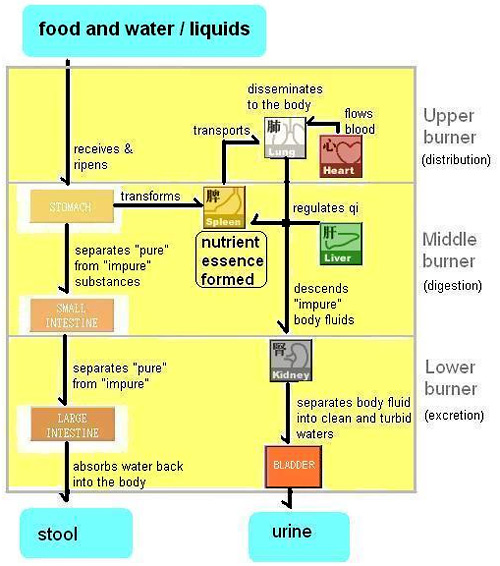TCM Understanding of How Stool and Urine Are Formed
Chapter 21 of the Huang Di Nei Jing (Yellow Emperor's Internal Classic) states: "When fluids enter into the stomach, they will be carried upward to the spleen and go through transformation and transportation functions. They are then turned into nutrient essence and are transferred further upward to the lungs. The lungs move and adjust the water channels, which direct the fluids to descend to the kidney and bladder. As a result, the whole process enables the water vapor to scatter to the skin pores and irrigate the meridians of the organs." These statements reflect that body fluids are made of nutrient essence absorbed in the stomach and spleen where they are disseminated and descended by lungs to the entire body. Finally, the kidneys collect "turbid" water or left over body fluids. If the body cannot reuse these fluids, they are sent to the bladder for storage and excreted as urine. TCM describes the urinary formation in the kidneys and bladder as the vaporization process.
The process of stool formation is similar. After food is received and ripened in the stomach, it is transformed and transported by the spleen. The "pure" (nutrient essence) goes from the spleen up to the heart and lungs where it is distributed to the whole body; the "impure" (partly digested foods) go to the small intestine where it is further separated into "pure" and "impure" substances. Finally the "impure" (waste) substances are directed down to the large intestine. The large intestine receives the "impure" parts of the digested food from the small intestine and continues to absorb water from these materials. At the end of the process, stool is formed and excreted through the anus.
Everything is interdependent and mutually interactive according to TCM theory; formation and excretion of urine and stool are supported by every part of the entire internal system. Among the organs, the kidney and the liver are actively involved with each other. The kidneys' vaporization function ensures the proper distribution of body fluids and excretion of urine by the bladder; moreover, the kidneys' propelling and warming functions enhance spleen, stomach and intestine functions. Because the liver regulates qi movements, it's flowing and spreading functions are crucial to spleen health.
| Flow chart of stool and urine formations from a TCM perpective |
 |
| |
|